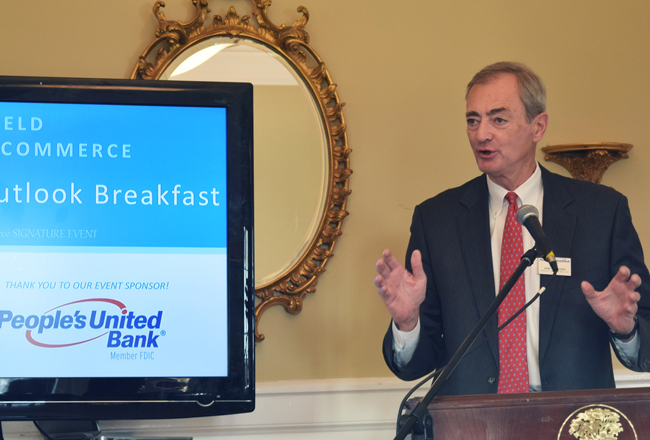The national economy will be tested by financial and political forces that will slow but not stop continued growth, according to John Traynor, executive vice president and chief investment officer at People”™s United Bank.

Speaking at the Fairfield Chamber of Commerce”™s 2019 Economic Outlook Breakfast, Traynor noted that the U.S. economy is showing no signs of grinding to a halt, let alone going into reverse.
“If we go to June 30, we will be tied for first place for the longest economic recovery,” he said, noting the stretch that began in the third quarter of 2009 following the Great Recession. “This has been an incredibly long recovery. To use a baseball analogy, we”™re in the seventh or eighth inning.”
Traynor added that he did not share the concerns of a possible recession this year or next year, but he added that the “sugar rush” economy of 2018 will be followed by slower growth in the immediate near future. Traynor pointed out that the problems facing the economy became more acute in the final three months of 2018.
“In the fourth quarter, it was really a confluence of Wall Street, Main Street ”” Main Street basically being the economy ”” and Pennsylvania Avenue,” he said. “We saw all three come together and cause problems in the fourth quarter. What we”™re seeing now is this rebound in the market with the Fed coming out and saying, ”˜We acknowledge what”™s going on in Washington is causing some concern. We see the economy slowing down.”™ ”
Traynor argued that Pennsylvania Avenue is creating the most agita for the economy, especially with the continuation of the partial federal government shutdown and the inability of Congress and the White House to reach common ground to end the situation. The impact of this, Traynor observed, is already being tracked in consumer confidence data.
“When people think about the future, they”™re less confident,” he said. “That”™s going to show up in the economy. Not that we”™re going to fold up our chairs and stop spending, but maybe we”™re not going to put that extension on the house or renovate the kitchen. That”™s going to show up in the GDP growth. We feel good now, but our expectations are low.”
Traynor also pointed to partisan political divides as having a problematic effect on shaping future economic policy. Pointing to statistics on regional voting trends in the 2016 and 2018 elections, Traynor presented a nation where “red areas became redder and blue areas became bluer as the country moved further apart rather than come together.” This scenario, he warned, will create difficulty in building consensus on future federal economic policies.
And while Traynor did not take sides in the political debate, he had no qualms calling out the Trump administration”™s tariff strategy, arguing that it could result in major problems for Connecticut”™s aerospace industry.
“Aerospace drives our manufacturing business,” he said. “If aerospace turns over, then Connecticut has a big problem. I”™ll go out on a limb and say absolutely ”” not a maybe ”” that it”™s a mistake.”
As for Main Street, Traynor recalled that in his meetings with regional business owners they are happy regarding the health of their operations but frustrated with trying to find enough employees to handle the growing work. Statistics show that post-Great Recession Connecticut has swapped higher-paying finance and manufacturing jobs with lower-wage service sector jobs, which are not bringing in the revenue levels needed to fund state government adequately.
Adding to Connecticut”™s problems is a decline in population levels over the past few years. Yet Traynor pointed out that Fairfield County”™s population grew by 3.6 percent between 2010 and 2017 ”” the only other Connecticut county with positive growth was Hartford County, albeit with a relatively anemic 0.2 percent uptick. Neighboring Westchester County is sharing Fairfield County”™s population expansion, growing by 3.3 percent during the same period.
“Fairfield County and Westchester County are doing pretty well,” he said. “When people are 25 to 34, they tend to move to New York or Boston. But when they get to 35 to 44, a lot of those people are coming right back here.”





















